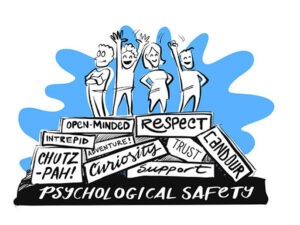
Among many different aspects of work-life mental health, and psychological safety is an important aspects. Psychological safety is the ability to share thoughts, opinions, questions, and concerns without feeling the weight of being humiliated or shamed in the workplace; this provides employees with a sense of security and safety at their workplace.
PsychSafety UK explains the four stages to attain psychological safety namely that was described by Timothy Clark These are:
- Inclusion safety: Psychological safety starts with employees feeling they belong in the team.
- Learner safety: In the next stage, employees are not afraid to ask questions making them secure learners.
- Contributor safety: In this stage, employees are comfortable sharing their ideas.
- Challenger safety: In this final stage, employees are not afraid to provide their input and suggestions for improvement.
Although it may not be possible to move through these stages linearly, the four stages can be used as a model while fostering psychological safety in the workplace.
Importance of Psychological Safety
With Psychological Safety, employees feel respected, notice that their work is valued, and feel accepted for who they are and for the strengths that they bring to the table. When employees feel intimidated to express their opinions and issues about the organization or its functioning, it hinders the growth of the company.
Benefits of Psychological Safety:
- Necessary for employees to flourish, stay motivated, and increase the quality of work.
- Directly impacts the employee’s mental health.
- Helps to increase team collaboration.
- Prompts an open dialogue, and provides comfort, understanding, and empathy for team members.
- Affects the organization’s climate and culture and is related to employee engagement and performance.
Leadership behaviors that create psychological safety
McKinsey & Company suggest two types of leadership behaviors that promote psychological safety: Consultative leadership behaviors, where the leader values the team members’ input and views, and Supportive leadership behaviors, where the leader caters to the team members’ concerns and supports them not only as an employee but also as an individual. Additionally, they suggest that leaders can further instill psychological safety by:
- Addressing unconscious biases
- Mindful listening
- Situational awareness
- Developing high-quality relationships with employees
- Having an open dialogue
- Showing cultural and self-awareness.
PsychSafety UK, lists three core leadership behaviors help create psychological safety that was described by Amy Edmondson:
- Frame work as a learning problem rather than an execution problem and focus on learning from the experience and how to do better next time
- Acknowledge fallibility, and in doing so encourage employees to do the same
- Modeling curiosity by asking questions where employees feel secure to share ideas leads to better performance of the team
In conclusion, for an organization to grow and make a real difference in the lives of its employees and leadership, incorporating such skills at any leadership level will help create a positive workforce environment and positively impact your and your employee’s mental health.